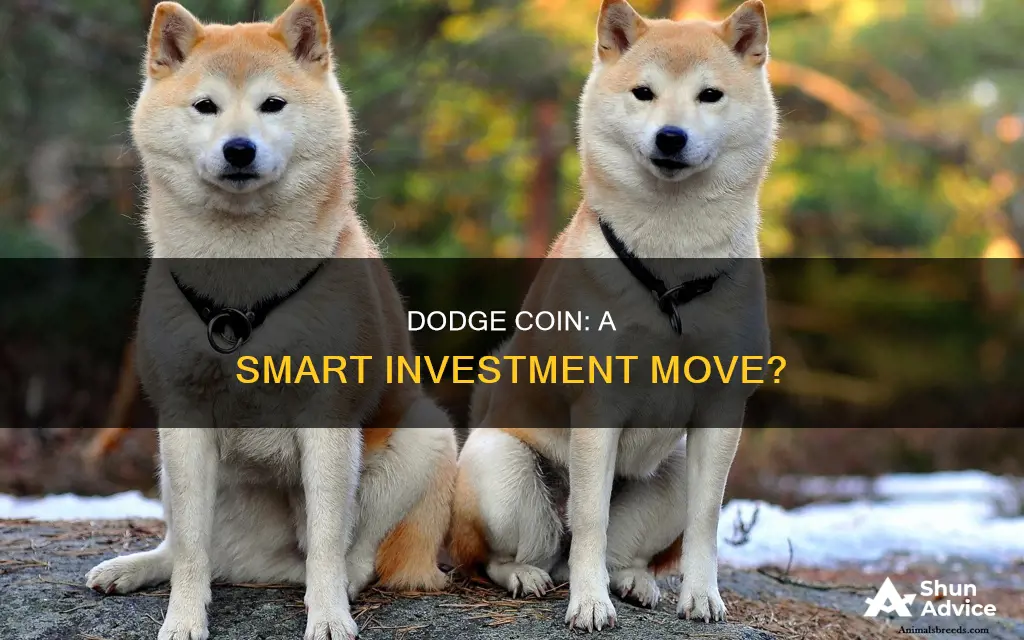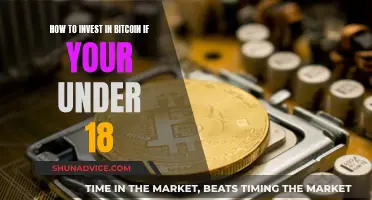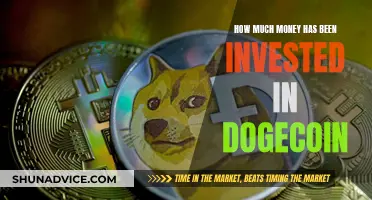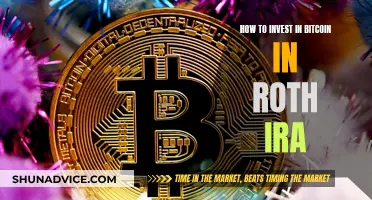
Dogecoin is a popular cryptocurrency with a passionate community, but is it a good investment? Dogecoin is a unique cryptocurrency because it was born as a meme or a joke, and it has no clear use case or a big platform backing it. Despite this, it has experienced remarkable surges in value and has a market capitalisation of over $11 billion. However, Dogecoin has no intrinsic value and its technology is not groundbreaking, so it is a risky investment. Dogecoin's value is largely driven by market sentiment, social media hype, and speculation. Its price is very unpredictable and vulnerable to news and endorsements. While Dogecoin may be a good investment for some, it is important to understand the risks involved and do your own research before investing.
| Characteristics | Values |
|---|---|
| Price | $0.08 - $0.10 |
| Price Fluctuations | Very unpredictable |
| Market Capitalization | Over $11 billion |
| Ranking | Number eight in the crypto ecosystem |
| Supply | Unlimited |
| Utility | Low |
| Community | Loyal and growing |
| Transaction Fees | Low |
| Investment Option | Not stable |
| Risk | High |
What You'll Learn

Dogecoin's price history
Dogecoin, the original "meme coin", has experienced a surge in value since the beginning of 2024, with its price up by 48% at the start of May. This cryptocurrency, initially created as a parody, gained immense popularity during the last bull market, reaching a peak of over $0.70. However, Dogecoin's fundamentals remain questionable, and it lacks intrinsic value and meaningful utility.
Dogecoin was launched on 6 December 2013 by software engineers Billy Markus and Jackson Palmer. It is a fork of a now-defunct cryptocurrency called Luckycoin and runs on a proof-of-work network methodology where miners receive payments for validating transactions. Unlike Bitcoin, Dogecoin has an unlimited supply, which makes it risky compared to Bitcoin's limited supply.
Dogecoin's price remained flat for the first seven years after its launch. The world's largest meme coin witnessed its first price change in December 2020, followed by a major upside in the first half of the 2021 bull run. The coin posted a 9,884% gain between January and May 2021, reaching a new all-time high of $0.74. This surge was partly driven by Tesla CEO Elon Musk, who has been a strong supporter of Dogecoin.
However, Dogecoin's price fell below $0.001 in the second quarter of 2017 and took almost four years to recover. It wasn't until November 2017 that Dogecoin's price found support again from bullish investors, and by January 2018, its price had reached $0.018. The coin experienced a prolonged period of low trading activity as hype for the token waned, and it took over three years for it to reach that level again.
As of May 2024, Dogecoin is valued at around $0.08, with a market capitalization of more than $11 billion. Despite its popularity and a devoted community, Dogecoin is not considered a stable investment option by seasoned investors due to its unlimited supply and lack of real-world utility. Its price is highly dependent on social media posts and is subject to wild fluctuations.
Ghanaian Guide to Bitcoin: Getting Started with Crypto
You may want to see also

Dogecoin's future prospects
Dogecoin is one of the most popular cryptocurrencies in the world, with a massive community and a top-10 market cap. It has experienced remarkable surges since its creation, with its price up by more than 48% since the beginning of 2024. It is also the only meme coin in the crypto universe that surged by more than 15,000% in 2021. Dogecoin has a passionate community, fast transaction speed, and a unique market position, which makes it a worthy investment option for the long term.
However, Dogecoin also has its limitations. It is regarded as a joke coin or a meme coin, and its prices fluctuate more often than other cryptocurrencies. It also has an unlimited supply, which makes it a risky token compared to Bitcoin, which has a limited and definite supply. Dogecoin also lacks intrinsic value and meaningful utility, and its technology and development are far from groundbreaking.
Overall, Dogecoin's future prospects look promising, but it is still a highly speculative and volatile investment. Its unlimited supply model presents long-term risks compared to more established coins, and its meme popularity may not sustain it indefinitely. The broader crypto market's performance will also significantly impact Dogecoin's trajectory.
Apollo Coin: A Smart Investment Decision?
You may want to see also

Dogecoin's pros and cons
Dogecoin Pros:
Dogecoin has a growing community of holders and supporters. Its investors use it as an absolute value and are very active on social media platforms, sharing memes as part of its promotion. Dogecoin is also easy to buy and sell, with low transaction fees.
Dogecoin is compatible with the emerging decentralised finance movement within the crypto market. It can be transacted and traded on decentralised exchanges, and the Ren project has enabled it to work on the Ethereum blockchain platform.
Dogecoin shares similarities with Bitcoin, which makes it secure and easier to transact. There are no mining limits, and it has a unique market position as an inflationary coin with indefinite supply.
Dogecoin Cons:
Dogecoin has questionable fundamentals and lacks intrinsic value. With an unlimited supply, it will struggle to maintain value in the long term. Dogecoin's technology and development are far from groundbreaking, and it has no meaningful utility.
Dogecoin is not widely accepted as a transactional currency like Bitcoin or Ethereum. It is also subject to too much price volatility and is highly dependent on social media posts and comments by Elon Musk to drive its price.
Dogecoin is associated with pump-and-dump schemes, where a group of people manipulate the price by buying a large number of coins, causing a substantial increase, and then selling them at a higher price. This can result in significant losses for long-term investors.
Dogecoin's fun nature might contradict real innovation, and it has relatively poor technical support. It was initially developed to poke fun at existing coins, which may obstruct integrations and adoption as a digital asset.
Bitcoins: Investment Opportunities, Pros, and Cons
You may want to see also

Dogecoin's value against other cryptocurrencies
Dogecoin is often compared to other leading cryptocurrencies like Bitcoin and Ethereum. However, unlike Bitcoin, Dogecoin has an unlimited supply, which makes it a riskier investment option. Dogecoin also differs from Bitcoin in its use of Scrypt technology in its proof-of-work algorithm. This means that miners need dedicated field-programmable gate array and application-specific integrated circuit devices for mining, which are more complex to produce.
Dogecoin's blockchain cannot interact with smart contracts directly, but it can be tied to the Ethereum blockchain to access some decentralised finance instruments. Dogecoin's target block time is also faster than Bitcoin's, at 1 minute compared to 10 minutes.
Dogecoin is also similar to Litecoin, as it was forked from this cryptocurrency and therefore inherited many of the same features, including the hashing algorithm. However, Dogecoin differs from Litecoin in its branding and large inflationary supply.
Dogecoin has been described as the first "meme coin", and it is often compared to other meme coins. One source suggests that Dogecoin is more established than other meme coins, as it has a strong and growing community, while another source suggests that Dogecoin is more widely accepted than other meme coins. However, Dogecoin's value is still largely driven by social media hype and its loyal community, rather than any solid fundamentals. This makes it a riskier investment option than more established cryptocurrencies.
Hedge Funds: Exploring Bitcoin Investment Opportunities
You may want to see also

Dogecoin's viability as a payment option
Dogecoin is a cryptocurrency that was launched in 2013 as a joke based on a meme. It has since grown in popularity and market capitalization, becoming one of the leading and popular cryptocurrencies. However, it is different from other digital currencies like Bitcoin and Ethereum. Dogecoin has an unlimited supply, which means it is an inflationary coin. This makes it a risky investment option compared to Bitcoin, which has a limited supply.
Dogecoin can be a good payment option due to its low transaction fees. Several companies have started accepting Dogecoin as a payment option, partly due to the constant endorsement of Twitter's CEO, Elon Musk. Dogecoin is also easy to buy and sell, and it has a strong and growing community. However, it is not as widely accepted as Bitcoin and Ethereum, and its price is highly volatile.
While Dogecoin has the potential to be used as a payment option, it is not widely accepted, and its value as a currency is questionable. It is important for prospective investors to understand the risks associated with investing in Dogecoin and other cryptocurrencies.
Why Invest in Bitcoin: Making Money with Cryptocurrency
You may want to see also
Frequently asked questions
Dogecoin is a risky investment due to its high volatility and reliance on social media posts and endorsements. It is not as stable as Bitcoin or Ethereum, and its value is largely driven by speculation. However, it has a massive community, high trading volume, and a loyal following, making it one of the more reliable cryptocurrencies in the market.
Dogecoin is a highly speculative and volatile investment. Its value is largely driven by social media hype and endorsements from celebrities, particularly Elon Musk. The risk of investing in Dogecoin is that its prices can fluctuate significantly and are difficult to predict. Additionally, Dogecoin has no intrinsic value and lacks meaningful utility, making it less attractive to investors.
Dogecoin has a devoted community and has seen long-term price increases. It also has fast transaction speeds and a unique market position. Dogecoin is one of the most popular cryptocurrencies, and its price has the potential to reach over $1 in the next few years. It is also a good trading tool due to its volatile nature.







